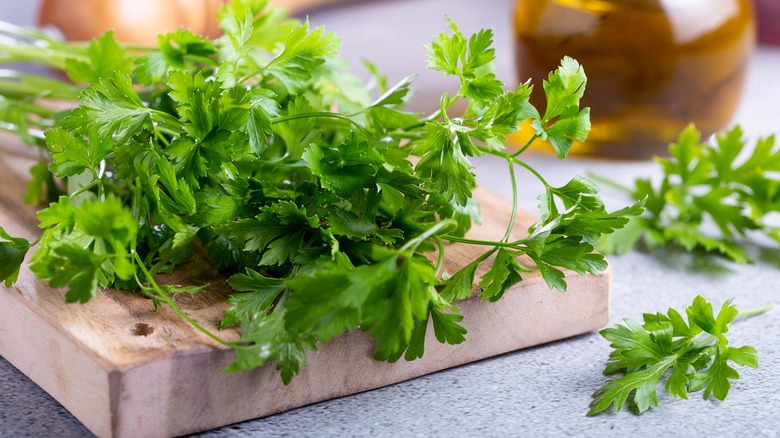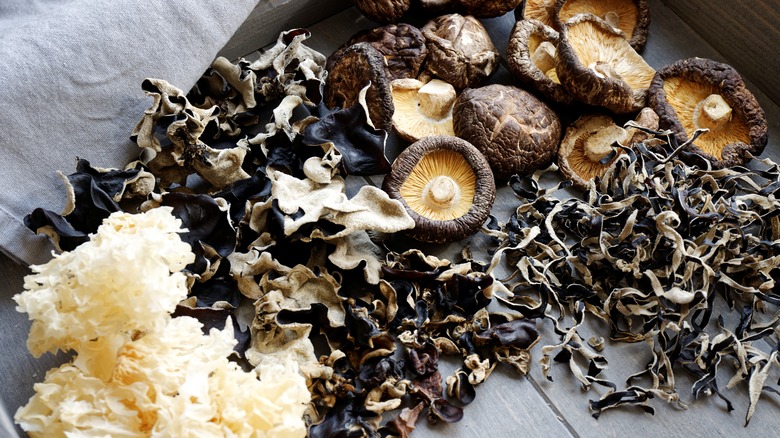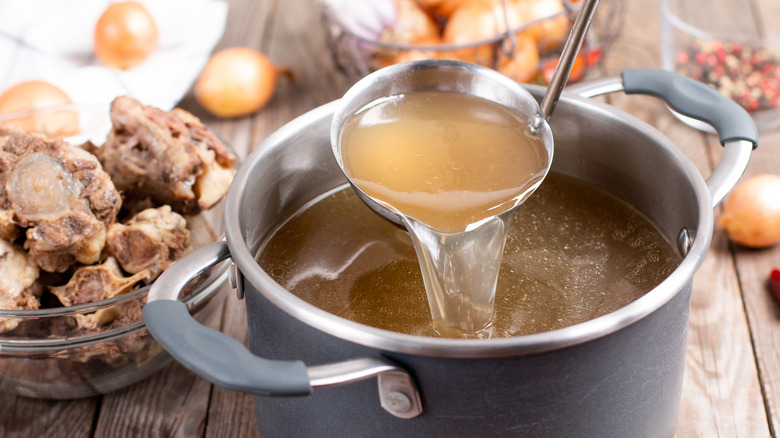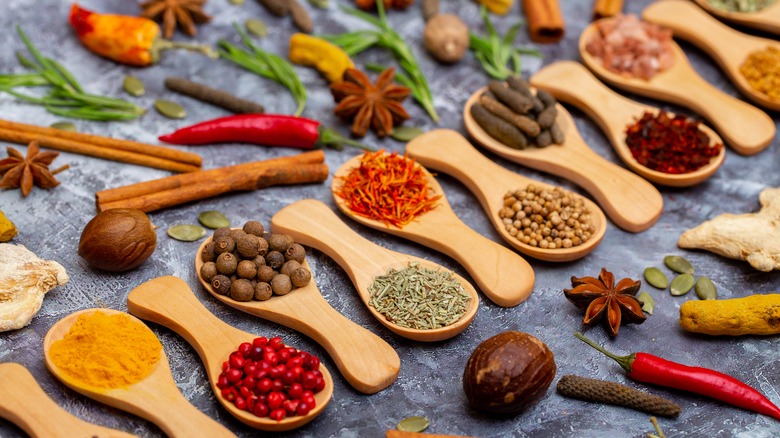15 Tips You Need When Seasoning Soups
Many people equate soup with winter, which is fair: There are few dishes as warm and homey as a hearty bowl of soup in the colder months. This said, cold soups also work well in the warmer part of the year, so it's important to remember that soup is a versatile, year-round dish.
Whatever season you're in, sometimes it can be hard to get the flavoring on soups right. Sometimes, they're too salty or not flavorful enough; other times, they lack something, and you're not quite sure what it is. It can be frustrating, especially after spending a considerable amount of time prepping ingredients, carefully following a recipe, and letting the dish simmer over the heat.
Every soup is different, so there's no one cure-all for under-seasoned soups. Still, there are a few tips that can offer a good "rulebook" to follow and help ensure that the soups, stews, chowders, and similar dishes you make turn out as flavorful as possible.
1. Make your own stock or broth
One of the simplest (and possibly most satisfying) ways to better season soups and improve their flavor is to make your own stock or broth. Homemade stock or broth can be enormously flavorful, as well as customizable based on your own tastes. It can be made with a variety of bases, and it can be stored in the fridge for the short term or for longer in the freezer. And while it's essential in soups, it can also come in handy for cooking grains and other dishes.
Stock or broth can be easily made at home, and it involves simmering meat, herbs, and vegetables in water and then straining them out. The main difference between the two is essentially that stock is thicker and is typically cooked with bones, producing a more gelatinous texture (bone broth can be considered more akin to stock).
Chicken is a common base for stock or broth, but both can be made with beef, turkey, and other meats, or simply vegetables, although technically, you cannot make true "vegetable stock" as you won't be using bones. Whatever you go with, you can use the result to add a rich depth of flavor to your soup.
2. Roast or sauté the veggies first
Adding many different vegetables to soup is certain to enhance its flavor, right? Well, it depends. Simmering vegetables in water or broth is definitely bound to impart some flavor: After all, this is how broths and stocks are made. This said, "pre-cooking" your vegetables before adding them to a soup can actually significantly boost the ultimate flavor.
The easiest ways to do this are by either sautéing your vegetables at the start of your recipe or roasting them prior to beginning the soup. How does this help? It basically helps to draw out the flavors of the veggies, making whatever you're using more vibrant than if it were just dropped into boiling liquid.
Caramelization, in particular, helps enhance the flavor by oxidizing sugars in the vegetables, giving them a particularly sweet and rich flavor. This is especially important with high-sugar ingredients like carrots, onions, beets, and other roots.
3. Season at the end
One of the more frustrating things that can happen when making soup is doing everything right, carefully following a recipe, waiting an hour or more for it to be done, tasting the soup, and finding that something's not right. It can be a real let-down, and you may start to feel like all that time you put in has gone to waste.
Fortunately, for the most part, it's really never too late to season your soup. Obviously, key spices like salt and pepper are often explicitly added at the end of cooking, with the assumption that they will need to be done to taste. But other herbs and flavors can be added too.
Heartier herbs like rosemary will benefit from enjoying some cooking time, but softer herbs like chopped parsley, mint, and others can usually be adequately added at the end of your cooking time. If you do add additional flavor, though, be sure to thoroughly stir it in and give it a few minutes to work its way into the soup before serving.
4. Add umami flavor
Sometimes a soup is just missing some key flavor. Occasionally it's easy to put your finger on it: For instance, maybe your soup just isn't salty or sweet enough. Other times it may be a little more ambiguous, and in such cases, it may be worth adding some umami flavor to your dish.
What is umami? If you're not familiar with the term, it is a particular "taste" (like salty, sweet, bitter, and sour) and derives from the word "delicious" in Japanese. It was identified and given its name by a Japanese chemist, Kikunae Ikeda, in the early 20th century. The particular flavor derives from glutamic acid.
Umami is, in some ways, the kind of flavor where "you know it when you taste it." It's found in seafood, aged cheeses, mushrooms, tomatoes, and a host of other foods; the addition of these foods and others (like dried shiitake mushrooms, tomatoes, miso paste, and more) can all bring that rich umami flavor to your soup.
5. Don't be afraid of sweeteners
"Sweet" might not be the first term that comes to mind when you think of a great soup. But in fact, sweetness is integral to many soups: For instance, soups made with winter squash, like this roasted butternut squash soup with brown butter, very much depend on sweetness to get the finished flavor right.
So if you're working on seasoning a particular soup, and things aren't quite right, it's worth considering whether a bit of sweetness might be missing. Sweet flavors might help balance salty or bitter flavors. And sweetness can be imparted in a few ways, using sugar, maple syrup, honey, molasses, or another sweetener, depending on what might work well with your dish.
Of course, it is crucial to do so in moderation. Too much sweetness can definitely be off-putting, and you don't want to ruin an otherwise good dish. If you do feel like you've added too much, you can work on adjusting it by gently adding acidic flavors like lemon juice or vinegar.
6. Add an acidic element
Acidity in itself can actually be a critical and sometimes overlooked flavor in soup. This might sound counterintuitive: After all, "acidic" is not often heard as a complimentary descriptor for soup. But "sour" is a key flavor, and balancing and properly amplifying the different tastes (sweet, bitter, sour, salty, umami) is important to crafting a delicious dish.
Various ingredients can effectively impart an acidic flavor into soup: These range from the more conventional (like lemon, black limes, or a little vinegar, which can be a good choice in broth) to the more complex (like fermented dairy products or even coffee).
It's a good idea to add a little at a time so as not to overwhelm your recipe. But it's an important flavor to experiment with, whether at the beginning, middle, or end of the soup-making process. Need a reminder of how good acidity can be in soup? Try this hot and sour soup recipe, in which (as the name indicates) sour is key.
7. Include a garnish
Sometimes it's good to season soups at the beginning of a recipe to get everything started on the right note; sometimes, doing so in the middle will help your flavors blend throughout the cooking process; and sometimes, adjustment at the end is all you need. Turns out there's a fourth option: Seasoning after the soup is done. Yes, seasoning and even a garnish will add a hint of flavor to your dish, and it may be what really makes your meal superlative.
Top Chef winner Kristen Kish suggests lemon zest, mint leaves, and shredded basil as good toppings. But what works for you might depend on the subtle flavor notes you wish to add to a soup. Cilantro and similar "delicate" herbs, like parsley, are often good choices. Whatever you decide, that extra little bit of flavor (plus the stellar presentation) could make a difference in the finished product.
8. Try making it a little spicy
If soup feels a little boring or under-seasoned, another thing it might be missing is heat! Adding a little kick to your soup can be an important way to jazz it up and make the flavor more complex (even if spicy foods aren't really your thing, a little bit of spiciness can add a subtle dimension to the dish without being overpowering).
Spiciness is great because it's so dynamic: Different types of peppers, sauces, and other additions will all add spiciness in their own unique way. Sometimes all you need is a little Sriracha or other hot sauce at the end of the cooking process. Alternatively, slow-cooking the soup with spicy flavors from the beginning can really let those flavors sink in. It may even have health benefits.
For instance, according to Healthline, cayenne pepper, which gets its heat from capsaicin, may be a good source of vitamins A and C, along with other nutrients, and may even benefit cardiovascular health. Finally, as always, spiciness helps balance out the other flavors, as in this spicy sweet potato soup recipe in which chili powder helps to offset the creaminess of the sweet potatoes.
9. Incorporate canned tomatoes
If you're a regular soup or stew maker, canned tomatoes may well be a standard part of your repertoire. But if they're not, it's important to take advantage of the remarkable versatility that canned tomatoes can bring to soup dishes.
First, as mentioned above, tomatoes are a crucial source of umami flavor. Tomatoes are also very healthy: According to the Canadian Medical Association Journal, the carotenoid lycopene, which is found in high levels in tomatoes, is very beneficial to human health, and it has been correlated with decreased risk of cardiovascular and other diseases.
You can use canned tomatoes in all sorts of ways. Caramelizing them with brown sugar is one quick trick for bringing out their sweet richness. But even tomatoes added directly to soup can also work plenty well: For instance, canned fire-roasted tomatoes play a critical, if simple, role in this black bean soup.
And don't forget about the variety of canned tomatoes: This creamy tomato tortellini soup, for example, calls for canned diced tomatoes, canned tomato purée, and canned tomato paste.
10. Try a bouquet garni
Adding herbs to soup is important, but it can come with some downsides. First, sometimes it takes a lot of herbs to add enough flavor, and the prep (particularly if you're starting with fresh herbs) can be tedious. Herbs can also be a mixed blessing in soups: While herbs like rosemary, thyme, oregano, and bay leaves can impart crucial flavors, not all herbs break down well (or in the case of bay leaves, at all), and they can be a textural problem in your finished product.
One remedy for this that still allows you to infuse a depth of herby flavor into your dish is using a bouquet garni. A bouquet garni (French for "garnished bouquet") is a bundle of herbs that is added to soups and other dishes, allowed to infuse into the recipe, and then removed before serving.
It typically uses fresh herbs like parsley, thyme, bay leaves, and others, but this can be varied with herbs like oregano, rosemary, marjoram, or whatever else you think will go well in your soup. It's easy to assemble, packs lots of flavors, and avoids unpalatable issues that can otherwise arise with fresh herbs.
11. Use bay leaves
Speaking of herbs, one is sometimes more critical than the rest in soups and other dishes: Bay leaves. This is a type of leaf that comes from the bay laurel plant and is frequently used in its dry form. In addition to soups, bay leaves impart a particular aromatic flavor to broths, rice dishes, and other grains, sauces, and more.
But as mentioned above, bay leaves can be frustrating in one respect: They do not break down. Normally this isn't a problem because bay leaves can be pretty easily removed from a dish after it's done. But if you forget to do so, you or a guest may end up taking an unfortunate bite that contains the hard leaf.
Still, if you can remember to remove it, these do add a unique seasoning to your food that you can't really get anywhere else. Spices also easy to keep on hand: You can store them dry for a long time in your pantry or keep them good for a while in your freezer.
12. Try different types of stocks/broths
Chicken broth and chicken stock are particularly common when cooking, but it's important to remember that these are hardly your only options for seasoning a soup. Other bases, like beef, turkey, and fish stocks, can all be readily found in stores and can easily lend a variety of flavors to all sorts of different recipes.
For instance, a seafood soup, like a hearty bowl of clam chowder, might benefit especially from using fish stock. That said, a chicken base can also work well and may serve to effectively balance out the fishier flavors of the clams.
In short, if a soup is coming out under-seasoned, consider altering its base. Whether you buy it at the store or make it at home (see this tasty beef stock recipe), you may be surprised to see how much more expansive the flavor becomes when its main cooking liquid is altered.
13. Toast your spices
Roasting or sautéing veggies before making soup isn't the only "toasting" that can brighten up a soup. Toasting spices beforehand can have a similar effect, amplifying a recipe's flavors and bringing out newer and more vibrant notes.
Chef Floyd Cardoz describes the way heat draws out aromatic oils in spices, pointing out the utility of this simple trick. If you have whole spices, these can be cooked in a pan over heat (while tossing frequently to avoid burning) and then ground, if necessary, and incorporated into your dish. Pre-ground spices should be mixed with cooking liquid before being heated in oil, as otherwise, they have a propensity to burn.
In general, it's important to be very attentive when toasting spices because they tend to be small and delicate and can burn easily. But this simple seasoning trick can help the spices you're using in your soup "pop" and measurably improve a dish.
14. Remove excess fat
One frustrating thing that can happen when making soup or stew is ending up with a greasy oil slick on the top. While it won't necessarily ruin the flavor of your dish, it can be a little unpalatable and can distract from the otherwise notable flavors in your meal.
One simple way to avoid this? Lower the fat content in your soup. If you're using meat, be sure to trim off as much fat as possible so that this fat then can't end up making an unappetizing slick on top of the dish.
But if it's too late, there are ways to remove the fat. Skimming the soup, in other words, slowly using a spoon to remove that fat that's boiled to the top, can be effective, though a little tedious. For a novel trick, this TikTok video shows how to do something similar with a ladle full of ice cubes: You sit it gently on the surface of the soup, which attracts grease to the ladle's underside, allowing for convenient removal.
15. Make it creamy
Sometimes, no matter what you add to it, soup just isn't filling enough. The taste might even be quite good, and yet some element simply isn't there. One effective option can be making your soup creamier. Obviously, some soups are designed to be creamy: Think cream of celery soup, for instance. Other soups might benefit from the addition of a creamy ingredient; for instance, a tomato soup that's just a little too watery and isn't quite coming together.
For vegans, this can sometimes be tricky because traditional ingredients for adding creaminess to soup often include heavy cream, half-and-half, and milk. But non-dairy and vegan options are available. Tahini and nut butter are two good options for thickening up and making vegan soup. Just be careful to start slowly because you don't want to overpower the existing flavors in your dish, particularly when trying one of these substitutes.















